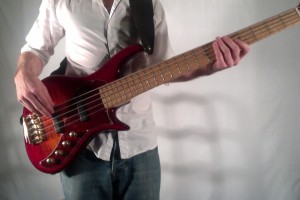When I first started playing, I wasn’t really concerned about how to hold a bass at all. I just wanted to play all of my favorite songs with my friends. I just slung it over my shoulder and away I went.
This was fine for a while, until I started having pains in my left wrist. This was really bad news and threatened to stop me playing forever.
There was more than one thing that contributed to this pain, but the way I was holding my bass was one of the main factors – but more on that soon.
Now I don’t like to talk in absolute terms, (everybody is different, you know…) and there is a little bit of wiggle room, but in general, there is a ‘right’ way to hold your bass and it pays to know it!
Take care of this sooner rather than later. The longer you wait to address this, the harder it will be and the more unnatural it will feel when you get around to correcting it.
Remember – it’s much more difficult to change a bad habit than it is to form a good one.
So do yourself a favor and try this.
How To Hold A Bass – The Steps

1. Sit Down
Sit up straight with your bass on your leg and get comfortable. Notice the position of your bass on your body. Unless your bass is outrageously shaped or missing large chunks, this will be the best place for your bass to be on your body.

2. Strap Up
Put on your strap and set it’s length. It should be sitting firmly in place while you’re still sitting down. That way, when you stand up, your bass will stay in the same place in relationship to your body.
You want your bass to become like an extension of your own body.

3. Stand Up
When you stand up, do you feel your bass sliding down your body? If so, sit back down and bring your strap up a notch or two. Keep doing this until you can stand up without your bass sliding down too much.
As it turns out, the pain that I was having was a result of having my bass WAY too low on my body. It was low enough that I had to put my wrist at an unnatural angle to play any of the notes.
If the pictures weren’t enough, try the video version.
Of course, everybody is different, but remember, that the more your bass is below the ‘sitting’ level, the more stress it puts on your fretting hand. Sure, it might look cool to be holding your bass around your knees, but is it really worth the potential carpal tunnel or tendonitis?
For me, it’s not…
I don’t want to risk any kind of serious injury that would stop me from playing. Being able to play is far too valuable to me.
If you’re reading this, I’m sure you’re the same way.
Remember – You play the bass…don’t let the bass play you!
If you have any questions or comments about how to hold a bass, leave them below. I read all of them. I’ll talk to you soon!




Greetings from Ron Carter (not the Ron Carter; I’m from Oregon.
Just starting, but I play four times a week with my worship band. My left hand cannot reach four frets. Do I work on stretching the hand or play higher on the fret board?
Hey Ron!
That’s a great question! For the moment, I would recommend playing higher on the fretboard rather than stretching your hand. You don’t want to overload your hand stretching too far in your low register. It can lead to all sorts of nasty things that can stop you playing and really do you some damage. (I actually fell into this trap – and ended up with tendonitis – my arm in a splint and a fair amount of pain when I played. It took a while to correct my technique)
Eventually, your hands will get more flexible and you’ll get more dexterity in them – THAT’s when you can start creeping down into the lower part of your neck. You’ll find that your hands will be able to stretch further than they could before – perhaps even further than you thought they could!
Cheers,
Luke
P.S. I did a massive double take when I saw a comment from “Ron Carter”. Haha!!!
Ron, try the bass ukulele. Frets are much closer, all the notes and tabs are identical to bass guitar and with a good amp it can sound like an upright bass as well.
I had a very heavy bass before but now I changed to one that’s much more light weight and I must say the above mentioned makes it easy for the left hand to move around the neck .thank you
Wat about players like the bassist in system of a down? Their bassist has his bass below his belly button , and their are players like Michael Jacksons bassist that keeps it near his chin almost? are they both right? Wat is too low to hold a bass?
Everyone’s body is different. The important thing in terms of your own technique is making sure you’re not putting your fretting hand wrist at too extreme of an angle. Doing that is a recipe for RSI, carpal tunnel and all sorts of nasty stuff that can put you out of action permanently.
Of interest! Think of how the Beatles hung their guitars. That was before Jimmy Page single handedly with his gun slinger approach to playing changed the look of cool guitarist forever.
Wow, sure glad I stumbled on this website today. Learned a bunch already and How To Hold a Bass was something I was wondering about. Made an adjustment in my strap and we’ll see how that feels. Basically a beginning bassist. Never played an instrument in my life and now I am retired wanting to learn a new skill. I’ve got the Starter Pack downloaded and plan to start on it right away. Thanks Luke for making this available. Happy New Year from Canada.
Awesome to hear Nick! If you have any questions along the way, just let m know. I’m always happy to help. Happy New Year!
A short scale bass can also help if you have smaller hands. Also lower the action of the strings and play lighter so it takes less effort to hold down the strings. I had a teacher that went to the bass institute and he had me put a thick pad between the bass body and the strings so that I couldn’t dig in too hard like I was doing. This taught me to sweep the strings more than digging in. This helped my endurance and kept my hands from cramping so I could stretch them out more.
I’m really interested in getting tab’s for blue’s song
Hi Luke, thanks for all this learning material (visual in video and by reading theoreticly). It works soo good together. Im an absolute beginner and this double and enthousiastic approach is wonderful and works very well for me. Hello from the Netherlands
HI Luke!
Unless I missed it on your website I didn’t see any lessons for technique (accept for the “strap test”) Do you have any lessons on using the left hand and how to stretch and use 4th and 5th fingers, etc?
Thank you!
Hey Josh – I have a few lessons that could be super helpful as technique exercises for stretching hands and using all your fingers. Check these out:
https://becomeabassist.com/killer-bass-workout/
https://becomeabassist.com/how-to-strengthen-your-pinky-finger/
Between the 2 of them, you should be able to develop some dexterity and strength in all your fretting fingers and coordinated them with your plucking fingers!
Hi Luke, I’m just getting started but something I just can’t seem to find a straight answer anywhere about: how do I hold my right hand without bending the wrist too dramatically? I’m really looking for proper plucking form, lessons I’m taking say to anchor the thumb on the pick up, but I keep playing around with different wrist and elbow angles and can’t seem to find a groove. I have ordered a padded strap which may help with the fatigue, but I want to get proper form now so I don’t get into any bad habits. Thanks.
Great question Rick and I’m really glad you’re approaching things with the mindset of trying to avoid developing bad habits. You’re definitely right that your right wrist shouldn’t be too dramatically bent, but a little is OK. The thing you want to avoid as much as possible is tension in your wrist and hand. If your wrist is bent a little, but nice and relaxed, you should be pretty well OK. If you have a little bend in your wrist but hold a ton of tension there, that’s where a real problem could come up. Even if your wrist was completely straight, but that caused tension for you, then you’d have the same kind of problem.
I’m sure the more you play, the more you’ll settle into a natural-feeling position with your wrist, even if it’s a little bent.
Hi Luke just looked at the first video in the beginner pack and just the part about how to hold the bass has made a difference, once I had adjusted the strap it made quite a difference thank you ( boy you where young in that video)
Awesome to hear you’re getting something out of the beginner pack Tony – and yes, I was much younger and much lankier back then!
Luke,
Thanks for the beginner pack. Even though I’ve played Bass since the seventies, ( I practiced hard back then and played covers) I didn’t really learn what I should have to become a knowledgeable player, so I’m starting at the beginnig now. Your approach and lessons are invaluable and now I’m on my way to becoming a Badass Bassist. Thanks.
Ken from Florida.
Luke,
Thanks for reminding me that there are anatomical differences. I watch your videos with you not wearing a strap, so took mine off. You looked so relaxed that way. But, due my proportions (shorter legs with longer mid section), the upper frets are very uncomfortable. It doesn’t look so cool wearing my bass like Brian Wilson with the headstock tipped up, but it’s the only way I can comfortably access frets above the 8th fret.